IGUANAS
 בלוי יגואַנאַ |  Albino יגואַנאַ |
|---|---|
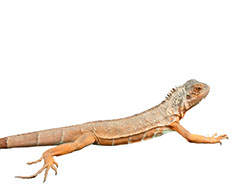 רויט יגואַנאַ | 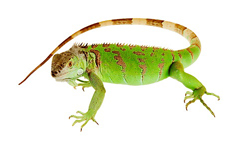 גרין יגואַנאַ |
יגואַנאַ קער שיט
גרייס: דערוואַקסן יגואַנאַס קייט אין נומער 4-6 פֿיס אין לענג.
לעבן שפּאַן: אויב רעכט קערד פֿאַר, יגואַנאַס זאָל לעבן מער ווי 20 יאר אין קאַפּטיוואַטי.
אַלגעמיינע אויסזען: יגואַנאַס ביסט וואָס רובֿ מענטשן טראַכטן פון ווען זיי טראַכטן 'ליזערד.' זיי האָבן פינף טאָעס אויף יעדער פֿיס. זיי פאַרמאָגן אַ פלעשי בלאַט פון הויט אונטער דער גאָמבע גערופֿן אַ דעוולאַפּ. כל יגואַנאַס האָבן ספּיינז וואָס לויפן די לענג פון די צוריק. פאַרקערט צו פאָלקס גלויבן, נישט אַלע יגואַנאַס זענען גרין. רובֿ דזשווואַניילז זענען העל גרין, אָבער ווי זיי עלטער און וואַקסן זיי קענען קייט אין קאָלירן פֿון אַ נודנע גרין צו ברוין אָדער אַפֿילו מאַראַנץ מיט סטרייפּט עקן.
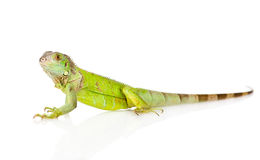
האָוסינג רעקווירעמענץ
אָפּצוימונג: די אָפּצוימונג פֿאַר אַ דערוואַקסן יגואַנאַ איז זייער גרויס. די אָפּצוימונג זאָל זיין לפּחות זעקס פֿיס הויך, וועגן 1
טעמפּעראַטור: יגואַנאַס קומען פון אַ טראַפּיקאַל קלימאַט און דאַרפֿן צו זיין געהאלטן וואַרעם. דייטיים טעמפּעראַטורעס זאָל זיין 80.
היץ / ליכט: ולטראַוויאָלעט לייטינג פּראַוויידינג ווואַ און וווב איז required פֿאַר געהעריק קאַלסיום מאַטאַבאַליזאַם און סקעלעטאַל אַנטוויקלונג. אָן די געהעריק לייטינג דיין וועט ווערן קראַנק און שטאַרבן אַ זייער ווייטיקדיק טויט. געהעריק לייטינג קענען זיין צוגעשטעלט יוטאַלייזינג די געפֿירט טובז ספּעשאַלי געמאכט פֿאַר נוצן דורך רעפּטיילז ווי געזונט ווי קוועקזילבער פּאַרע באַלבז אַז אויך צושטעלן עטלעכע היץ ווי געזונט. נאָך היץ קענען זיין צוגעשטעלט יוטאַלייזינג ינפראַרעד סעראַמיק עמיטטערס און ינקאַנדעסאַנט באַסקינג באַלבז. הייס ראַקס זאָל קיינמאָל זיין געוויינט אונטער קיין ומשטאַנד ווי זיי קענען סאַווירלי ברענען דיין יגואַנאַ.

סאַבסטרייט: יגואַנאַס וועט אָפֿט צונג לעקן זייער סוויווע. צוליב דעם רובֿ פּערטיקיאַלאַט סאַבסטרייט (האָלץ שייווינגז, מאַלטש, זאַמד, אָדער פּודער טייפּס) זענען נישט צונעמען פֿאַר רובֿ יגואַנאַס. צייַטונג מיט ניט-טאַקסיק טינט, קאַצעוו ס פּאַפּיר, פּאַפּיר טאַולז, דרינענדיק / דרויסנדיק קאַרפּאַטינג, אָדער קינסטלעך גראָז אַלע מאַכן ויסגעצייכנט ברירות. אויב ניצן דרינענדיק / דרויסנדיק קאַרפּאַטינג אָדער קינסטלעך גראָז ביטע זיין זיכער אַז עס זענען קיין דאַנגגאַלינג סטרינגס אַז קען פּלאָנטערן אין דיין יגואַנאַ ס ניילז. עס ס אויך רעקאַמענדיד אַז איר האָבן קייפל ברעקלעך אַזוי אַז איר זאלט פאַרבייַטן די סוילד ברעקלעך מיט די ריין שטעלן און דעמאָלט ריין און דיסינפעקט די איצטיקע שטעלן צו נוצן פֿאַר די ווייַטער רייניקונג.
Environment: Iguanas come from a tropical climate and require a humidity level of 65% to 75%. To achieve this may require several misting’s a day. Many people opt to purchase an automatic misting system instead.
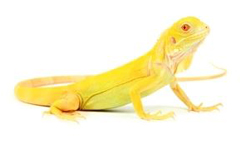
Diet: Iguanas are strict herbivores. Many older literatures will suggest feeding animal protein or even cat food. While some wild iguanas may ingest the occasional insect while eating leaves, it is not a significant portion on their diet. Iguanas that are fed too much animal protein will develop health problems and will die prematurely. A well balanced iguana diet will consist of about 40% to 45% greens (this includes, but is not limited to collard greens, turnip greens, mustard greens, dandelion greens (with flowers), escarole, and/or water cress), 40% to 45% other vegetables (this includes but is not limited to green beans, orange-fleshed squashes (butternut, Kabocha), snap or snow peas, parsnip, asparagus, okra, alfalfa (mature, not sprouts), onions, mushrooms, bell peppers, sweet potato, zucchini, yellow squash, and/or carrots), 10% or less of fruits (including, but not limited to Figs (raw or dried), blackberries, strawberries, raspberries, grapes, mango, melon (cantaloupe, honeydew, watermelon), papaya, banana, and/or apple), and less than 5% of other grains or commercial diets. Iguanas should never be rhubarb as it is toxic. Certain lettuces such as iceberg, romaine, and Boston butter lack sufficient nutrients and should only be fed occasionally. Acidic fruits (citrus, tomatoes, kiwi, pineapples, etc.) should also be only fed occasionally as well. Tofu can be occasionally offered as well for supplemental protein, though if too much is given it can lead to long term health issues. Wild plants and flowers are not recommended since they may be toxic to your iguana or may contain pesticides that could be toxic as well.
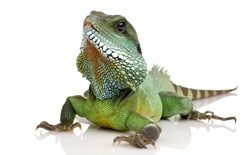
Maintenance: Cleanliness of the enclosure is essential. Waste products should be removed daily and the enclosure should be thoroughly cleaned and disinfected regularly. A 5% bleach solution provides an excellent disinfectant. Be sure to thoroughly rinse the solution from the enclosure before placing the iguana back in. Fresh water should also be offered at all times. Always wash your hands after handling your iguana or any of your iguana\'s cage accessories.